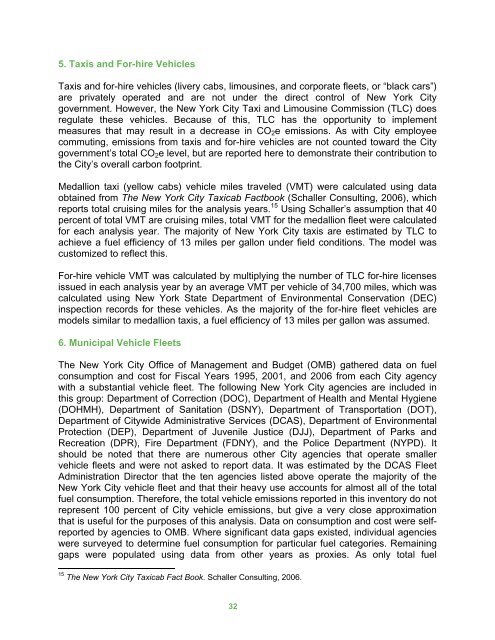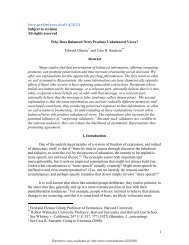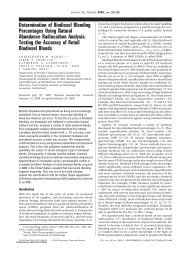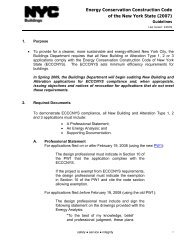GREENHOUSE GAS EMISSIONS - The Sallan Foundation
GREENHOUSE GAS EMISSIONS - The Sallan Foundation
GREENHOUSE GAS EMISSIONS - The Sallan Foundation
Create successful ePaper yourself
Turn your PDF publications into a flip-book with our unique Google optimized e-Paper software.
5. Taxis and For-hire Vehicles<br />
Taxis and for-hire vehicles (livery cabs, limousines, and corporate fleets, or “black cars”)<br />
are privately operated and are not under the direct control of New York City<br />
government. However, the New York City Taxi and Limousine Commission (TLC) does<br />
regulate these vehicles. Because of this, TLC has the opportunity to implement<br />
measures that may result in a decrease in CO 2 e emissions. As with City employee<br />
commuting, emissions from taxis and for-hire vehicles are not counted toward the City<br />
government’s total CO 2 e level, but are reported here to demonstrate their contribution to<br />
the City’s overall carbon footprint.<br />
Medallion taxi (yellow cabs) vehicle miles traveled (VMT) were calculated using data<br />
obtained from <strong>The</strong> New York City Taxicab Factbook (Schaller Consulting, 2006), which<br />
reports total cruising miles for the analysis years. 15 Using Schaller’s assumption that 40<br />
percent of total VMT are cruising miles, total VMT for the medallion fleet were calculated<br />
for each analysis year. <strong>The</strong> majority of New York City taxis are estimated by TLC to<br />
achieve a fuel efficiency of 13 miles per gallon under field conditions. <strong>The</strong> model was<br />
customized to reflect this.<br />
For-hire vehicle VMT was calculated by multiplying the number of TLC for-hire licenses<br />
issued in each analysis year by an average VMT per vehicle of 34,700 miles, which was<br />
calculated using New York State Department of Environmental Conservation (DEC)<br />
inspection records for these vehicles. As the majority of the for-hire fleet vehicles are<br />
models similar to medallion taxis, a fuel efficiency of 13 miles per gallon was assumed.<br />
6. Municipal Vehicle Fleets<br />
<strong>The</strong> New York City Office of Management and Budget (OMB) gathered data on fuel<br />
consumption and cost for Fiscal Years 1995, 2001, and 2006 from each City agency<br />
with a substantial vehicle fleet. <strong>The</strong> following New York City agencies are included in<br />
this group: Department of Correction (DOC), Department of Health and Mental Hygiene<br />
(DOHMH), Department of Sanitation (DSNY), Department of Transportation (DOT),<br />
Department of Citywide Administrative Services (DCAS), Department of Environmental<br />
Protection (DEP), Department of Juvenile Justice (DJJ), Department of Parks and<br />
Recreation (DPR), Fire Department (FDNY), and the Police Department (NYPD). It<br />
should be noted that there are numerous other City agencies that operate smaller<br />
vehicle fleets and were not asked to report data. It was estimated by the DCAS Fleet<br />
Administration Director that the ten agencies listed above operate the majority of the<br />
New York City vehicle fleet and that their heavy use accounts for almost all of the total<br />
fuel consumption. <strong>The</strong>refore, the total vehicle emissions reported in this inventory do not<br />
represent 100 percent of City vehicle emissions, but give a very close approximation<br />
that is useful for the purposes of this analysis. Data on consumption and cost were selfreported<br />
by agencies to OMB. Where significant data gaps existed, individual agencies<br />
were surveyed to determine fuel consumption for particular fuel categories. Remaining<br />
gaps were populated using data from other years as proxies. As only total fuel<br />
15 <strong>The</strong> New York City Taxicab Fact Book. Schaller Consulting, 2006.<br />
32







